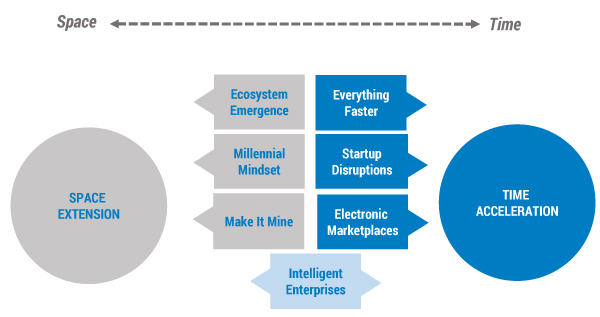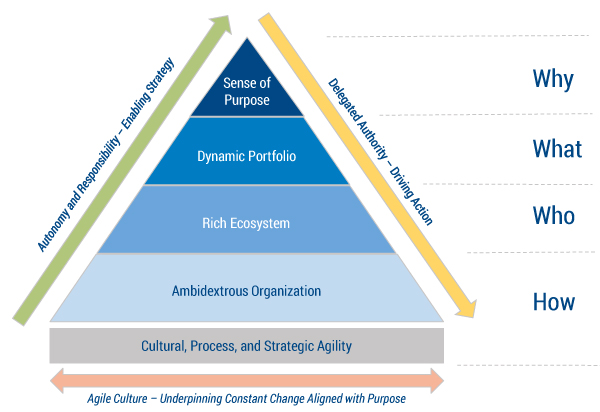CUTTER BUSINESS TECHNOLOGY JOURNAL VOL. 32, NO. 1
Cutter Consortium Senior Consultants Rick Eagar, Gregory Pankert, Raf Postepski, and Sean Sullivan discuss how the role of a CEO in 2019 is very different from that of a decade ago, primarily because traditional business boundaries are blurring while the pace of business continues to accelerate. The authors explore the changes in the CEO role and propose a new framework to help CEOs map the right strategic direction for their organizations.
The average tenure of CEOs has been falling steadily, down from nine years in 2000 to five years in 2017. Simultaneously, there has been a revolution in the nature of business itself: today only two of the world’s top 10 global companies by market capitalization — Exxon and Microsoft — are the same as about 10 years ago, while the business space leading companies occupy has radically changed. Being a CEO today is a very different experience from a decade ago. In the past, the new CEO would have known definitively the space that his or her business occupied and would be given at least a few years’ time to effect change. For today’s CEO, however, space has expanded while time has contracted. In this new “extended space, accelerated time” universe, the CEO’s role has become significantly more challenging; how can CEOs in 2019 navigate the right path for their organization and avoid getting “lost”? This article explores the changes and proposes a new framework to help CEOs map the right course.
The challenges of leading a large organization in an uncertain environment have always existed in the business world. However, it was not until the 1990s that these challenges began to attract attention in terms of leadership tools and approaches. The acronym VUCA, borrowed from the US military, characterized the issues: volatility, uncertainty, complexity, and ambiguity. Since then, CEOs have been urged to develop better resilience in their organizations to cope with VUCA (e.g., building in float or slack to cope with volatility, developing better intelligence to mitigate uncertainty, restructuring or bringing in special resources to address complexity, and using more experimentation to reduce ambiguity).
Until recently, even taking VUCA into account, businesses were mostly managed with similar goals and assumptions, such as:
-
A clear business vision and strategy, often with a five- to 10-year time frame, with an accompanying strategic plan cascading in a logical way down through the company to set multiyear priorities at business unit and operational levels
-
Continuity of a company’s core business, even when a degree of diversification was part of the strategy
-
A path to success achieved through aligning processes, resources, and organization with the strategy, and driving productivity and efficiency in a disciplined and systematic way
Additionally, there were well-established expectations of a new CEO, such as the following:
-
First year. Conduct a strategic review to develop the vision and strategy and deliver enough visible, quick wins to pass the “first 100 days” test.
-
Next two to three years. Implement the strategy, including top-line growth, productivity, and efficiency initiatives; improve business alignment; and take measures to adapt culture.
-
Following years. Reach performance and shareholder value goals.
In today’s business world, these traditional strategic approaches are increasingly inadequate due to significant changes in two basic dimensions in which companies operate: (1) there is an unparalleled requirement to consider potential extensions to the scope of the business (space); and (2) there is a huge acceleration in the required pace of the business (time). So what’s behind space extension and time acceleration? Figure 1 identifies some key trends driving these changes, which we address further below.

Space Extension
As standard products are replaced by experience and services, and new technologies are becoming increasingly ubiquitous, industries are converging and traditional business boundaries are blurring. This has led to a new ecosystem emergence in which previously unheard-of parties are jointly experimenting and collaborating to innovate and match customer and consumer appetites and imaginations. Moreover, the millennial generation is driving a sea change in consumer mindsets. The millennial mindset places a high value on the authenticity of a company’s long-term purpose, while simultaneously demanding responsiveness and adaptability to change. Many millennials seem comfortable without permanent employment and do not feel the same need to own the assets they make use of — whether houses, cars, bicycles, or technology. This has major implications for the business scope of companies that produce assets. Millennials also want to “make it mine” (although not in the sense of ownership) — but to stand out, make a statement, have an opinion, and trust in themselves to “do it their way.” In meeting the expectations mapped out by the space extension elements, today’s digital technologies can (and should) enable full personalization of products and services.
Time Acceleration
There are many drivers accelerating the pace of business. First, there is the underlying trend of “everything faster,” driven by technology, globalization, social norms, and economics. For business, this implies expectations of quicker decision making and time to market, continuous and accelerated innovation, and shorter ownership and/or alternatives to ownership.
Second, we are seeing startup disruptions to an extent never seen before — the examples of Uber, Airbnb, Amazon, and Netflix need no explanation in terms of their effects on the global taxi, hotel, bookstore, and premium content markets. What is new, however, is how technology allows startups to gain scale and achieve global reach within weeks or months instead of, for example, the decades it took McDonald’s to disrupt the restaurant business in the 1950s.
Third, the advent of electronic marketplaces (and platforms) has substantially accelerated the dynamics of business for consumers and producers alike. Electronic marketplaces impact how we buy and source, how we create and consume, and, ultimately, how we engage and choose, leveraging global and technology-based interactions between parties and peers.
And, finally, the digitalization of our society and economy is generating a more-than-exponential increase in the volume of data, profoundly affecting both the scope and the dynamics of business. The leveraging of artificial intelligence, robotic process automation, blockchain, and analytics by intelligent enterprises has led to both rapid and disruptive competitive advantage.
The Challenges for Today’s CEO
This business environment poses some tough challenges for today’s CEO, including:
-
Determining a dynamic and adaptive strategy. Determining a strategic direction is a core responsibility of the CEO. However, designing a strategy with a three- to five-year planning cycle is unrealistic. Today’s CEO still needs to create a strategy with a clear direction, but one that is more dynamic, is adaptive to change, and produces results quicker than was expected in the past.
-
Deciding what new business spaces to focus on. Conventional diversification around a stable core is not feasible if the core is vulnerable to disruption. To create value, today’s CEO must adopt a broader perspective of the company’s business models and the overall scope of the business portfolio, while simultaneously maintaining control of the core business to ensure short-term performance and license to operate. The CEO should be able to take the necessary steps and explore noncore initiatives (different stuff to what the business is currently doing) while at the same time get enough buy-in from the executive team and the board to allow for freedom to see it through.
-
Aligning resources to meet rapidly changing needs. Maintaining competitive advantage by having unique competencies is key for any company. CEOs today must decide, despite VUCA, what competencies the organization will need — both in-house and from the partner ecosystem — in the future.
-
Organizing the business to drive creativity and maintain control. The CEO needs to design an organization with enough explicit or implicit hierarchy to maintain control while empowering staff, breaking down silos, and removing barriers to creativity. Finding the right structures and models to support both objectives is often challenging.
-
Leading in an effort to create an Agile culture. Cultures that encourage experimentation, are tolerant of early failure, and support “fail fast, learn fast” have proven to be successful in the current business environment. Today’s CEO needs the right leadership style to encourage an Agile culture. Some CEOs rose to the top through being great entrepreneurs, and others through being great controllers, but the qualities needed for leading the organization today may be different.
The New CEO Space and Time Paradigm
To meet today’s challenges, the CEO needs a new paradigm to bridge effectively across control and creativity and to be able to meet the challenges of space extension and time acceleration. As Figure 2 illustrates, the key is to focus on five leadership priorities covering the why, what, who, and how:
-
Sense of purpose
-
Dynamic portfolio
-
Rich ecosystem
-
Ambidextrous organization
-
Cultural, process, and strategic agility

Let’s look at how each leadership priority can meet the challenges of extending space and accelerating time.
-
Sense of purpose:
-
Extending space. Redefine the playground, starting from the company’s overarching purpose and how it creates a unique competitive advantage that it can leverage and apply across converging industries.
-
Accelerating time. Take back control over the time dimension by clearly defining the immutable long-term purpose of the company and its implications on decision making, thereby enabling strategy to focus on the short-term decision cycle.
-
Dynamic portfolio:
-
Extending space. Align the portfolio with a sense of purpose that goes beyond product. Consider new, step-out business as a key part of business portfolio management.
-
Accelerating time. Use Agile approaches for new product/service development, maintain multiple pilots, and consider design before technology.
-
Rich ecosystem:
-
Extending space. Create an ecosystem of delivery partners in which the combined competencies drive competitive advantage greater than the sum of the parts. Unlock new, value-creation opportunities with nonobvious collaborations.
-
Accelerating time. Nurture mutual trust in your resource ecosystem and use new collaboration tools to rapidly deploy and engage the best resources from a wide network.
-
Ambidextrous organization (that is, blending productivity organization systems and creativity organization systems in order to simultaneously manage existing business lines):
-
Extending space. Expand the portfolio with disruptive initiatives.
-
Accelerating time. Rapidly launch and scale new businesses.
-
Cultural, process, and strategic agility:
-
Extending space. Lead a culture that accepts complexity and expects constant change and realignment, including strategy and portfolio, to enable achievement of your sense of purpose and vision through alternative paths.
-
Accelerating time. Delegate authority, empower the organization, and encourage autonomy to enable rapid decision making — but stay within the guiding principles of the sense of purpose and vision.
Insight for the Executive
Today’s environment of extended space and contracted time is significantly different from that of yesterday. New CEOs taking over the leadership of companies, as well as existing CEOs interested in effecting major transformations, should carefully reflect on how their organizations measure up to the five priorities of sense of purpose; dynamic portfolio; diverse ecosystem; ambidextrous organization; and cultural, process, and strategic agility.
In practice, this means reviewing the current status of the organization, identifying required changes, and taking the right approach to bring about transformation. Some actions and questions today’s CEO should consider:
-
Review the current status of the organization versus the space and time paradigm:
-
Is there a clear, enduring, and inspiring purpose for the company, above and beyond its products and services — and is this purpose activated in practice, both internally and externally?
-
Does the company take a truly dynamic approach to business portfolio review, and does it effectively address noncore growth?
-
Has the company leveraged the full potential of the innovation ecosystem?
-
Does the company operate both productivity- and creativity-based organizational models ambidextrously?
-
Is there a culture of agility, in which the business embraces complexity, encourages autonomy, and accepts constant change across strategy, processes, and ways of behaving?
-
-
Identify gaps and leverage points across each of the five priorities:
-
Where gaps exist, hold further discussions to understand the root causes, including the “unwritten rules” as well as more explicit factors.
-
Identify points of leverage that could be harnessed to bring about change, such as distinctive and unique aspects of vision and mission, examples of successful diversification, fruitful external partnerships, pockets of creativity for use as exemplars, and potential champions in terms of Agile thinking.
-
-
Engage and empower the organization for change:
-
Lead the implementation of a program of rapid transformational change, adopting Agile principles and working simultaneously across all five priorities.
-
Spend some time personally ensuring that a sense of purpose is clearly articulated and actuated in practice.
-
Engage the organization in the change and empower key individuals to take it forward.
-
Focus on rapid experiments to test feasibility and demonstrate progress and be prepared to change direction quickly as progress develops over time.
-
Many decades ago, Einstein discovered that the previously held Newtonian certainties about space and time were no longer valid, transforming the way scientists thought about the cosmos. At the more prosaic level of business in the 21st century, CEOs should also have a rethink.






